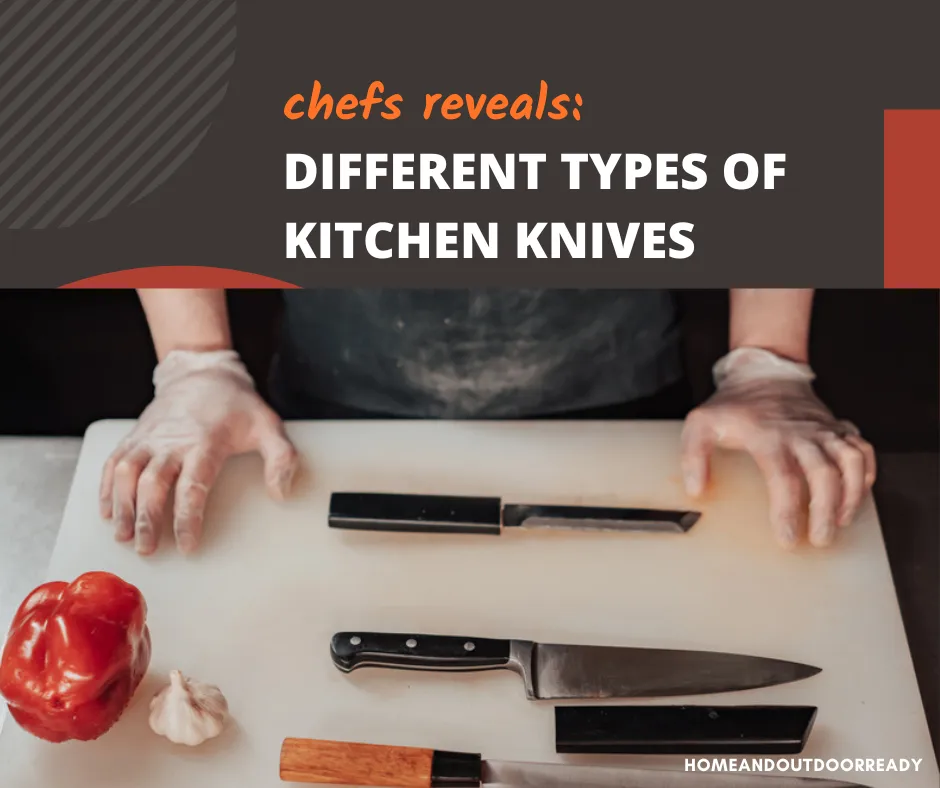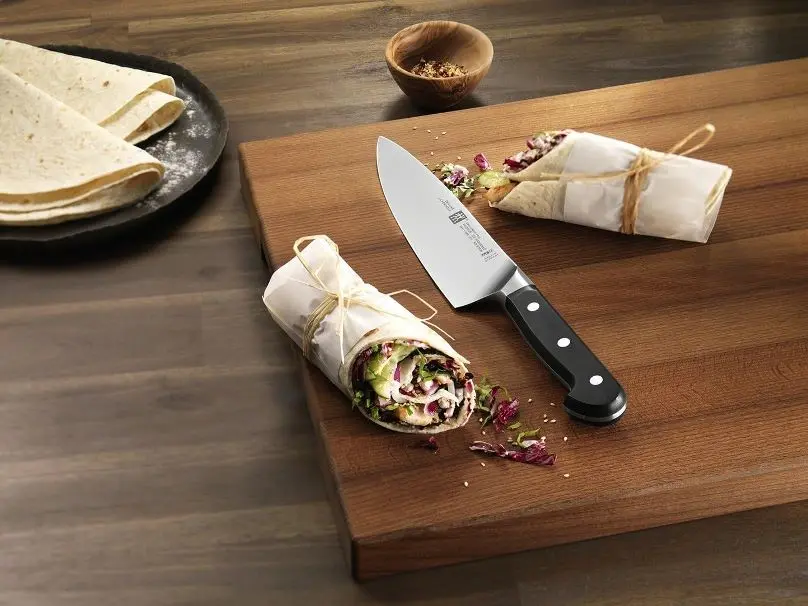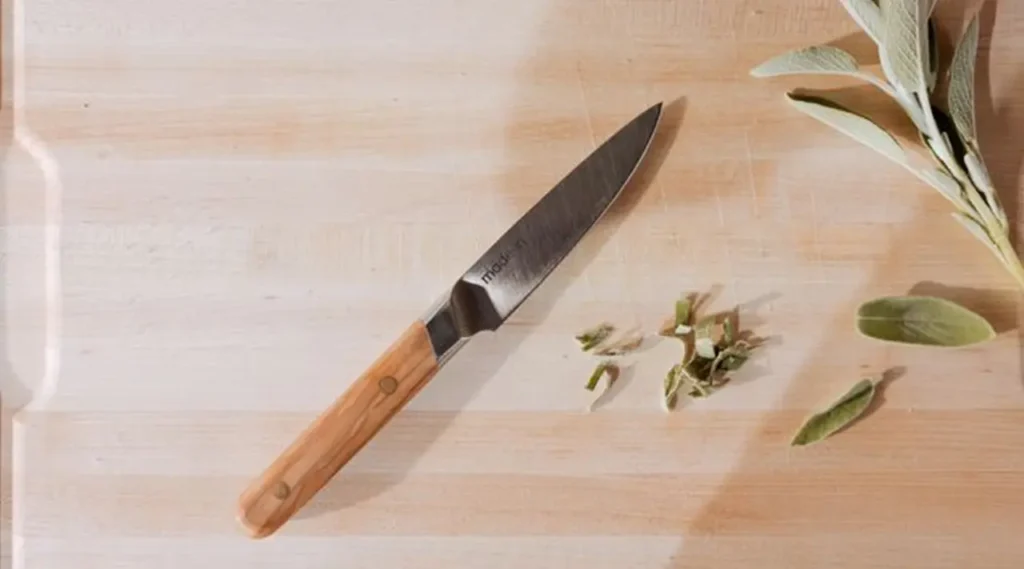We independently review everything we recommend. When you buy through our links, we may earn a commission.
Types of Kitchen Knives (A List of Different Kinds Cooking Knives and their uses)
Whether it is slicing or dicing, a quality knife is what makes your kitchen efficient and better equipped. But do you know what type of kitchen knife you own and the uses? There are many different types of kitchen knives for cooking.
Some are used for cutting, some for dinning and some are specific to meats.

In this guide, we will go over the different kinds of kitchen knives available on the market, their uses, and how to choose the right kind of cooking knife for your needs.
Types of Kitchen Knives for cooking (and their uses)
Chef’s knife

The chef knife is the most used knife in the kitchen. It is one of the most versatile knives around and can handle just about any type of cutting application. These types of cooking knives are used for a lot of cooking tasks by home cooks and professional chefs. It is one of the most common and widely used knives in any kitchen.
The most common cinema knife in any culinary-oriented movie, is the Chef’s Knife. A master for chopping and dicing. The thick rounded oversized blade allows for a back-and-forth rocking movement that makes chopping and cutting of veggies a breeze.
The blade is made to be sharp and is designed to cut or dice without being lifted off the chopping board. Yes, you must place the blade down on the chopping board and do the rocking motion while feeding it potatoes or other veggies that need dicing with the other hand.
Paring Knife

This knife is the smallest of all the knives coming in at about 3 or 4 inches in length. It is used to cut small fruits and make specific cutting applications on foods. These type of knives are great for peeling and very easy to use. I particularly use them for that purpose.
Size does not matter, especially when it comes to knives, and this is proven well by the Paring knife. The small undersized blade of the paring knife, the extreme sharpness, and the thin lightweight feel, makes it the perfect knife for precision and intricacy. Yes, they are generally available with the purchase of kitchen knives set and you better pull them out as they are very useful as well.
Being light in weight and nimble to use, a Paring knife can be used to perform surgery-level accurate cuts into any veggie or fruit that you choose for the paring knife to cut. Meat and produce handing with this knife is a big no-no. But peeling is a great use for the paring knife. Many home cooks prefer to use the pairing knife for peeling over the utility knife, because they are easier to use and handle very accurately.
Fillet Knife
A fillet knife is specifically designed to give you the lightweight handling and control your desire when cleaning fish. The blade tends to be very flexible yet durable to ensure that the meat separates from the bone and skin easily.
Santoku Knife
With more of a straight blade than that of a chef’s knife, this Japanese knife has small indentations that make it easier for food to slide off. This thick blade is best used for cutting and dicing but works better for items that tend to stick to the blade while cutting. They slide off with ease from a Santoku knife.
Like a chef’s knife, it’s also very versatile, great for dicing, chopping, and mincing ingredients or slicing cheese. You can use it for just about anything you’d typically use a chef’s knife for; both are great all-purpose knives.
Fish lovers would love how it makes the preparation of fish easier.
Boning Knife
This knife is specifically used to cut through bones. A boning knife does exactly what its name suggests with precision. It has an upwards tapering blade and a sharp narrow tip that allows for clean cuts through bones and cartilage of raw meat.
Like the cleaver, it is another meat-specific kitchen knife that is used only on raw meat and nothing else. Cooking meat with the bones, in some dishes, can cause heightened flavor and taste, but to do that, you need a boning knife to cut through the bones without causing the meat to be striped.
Cleaver (also known as the Butchers Knife)
This kitchen knife is specifically used to slice through meat with great ease. Cleavers are heavy, and on purpose, as the weight drives them clean through raw meat in a single strike.
The cleaver is one of the knives that you probably won’t see too often in a knife set but it does play a vital role in many cutting applications that need extra power or strength to cut through larger or tougher foods. It is also a great knife when you need to cut through bones or chop foods.
The name of this knife may sound scary at first because of Hollywood’s portrayal of this type of kitchen knife being used for all the wrong reasons in the movies. But they are actually a great kitchen knife to slice through meat like it is butter. Raw meats or butchery can be handled well with this meat-specific knife.
You do not dice veggies with this kitchen knife, you cleave. The only non-meat use of this knife is crushing garlic cloves as the large blade design supports fresh garlic.
Utility Knife
A utility knife is the smaller version of the chef knife. This Knife comes with a similar rounded blade on one side but is smaller and thinner than the chef’s knife. The blade is also much sharper and more agile than the Chef’s knife, allowing for delicate use. Also, it an essential in your kitchen because of the agility and the versatility it provides by being lighter and easier to handle.
A utility knife is made to go where the chef’s knife is a bit too thick to reach. Though they can perform most of the tasks of a chef’s knife, the Utility knife is better used for accurate cutting, like smaller and finer dicing, where the chef’s knife literally mashes things instead of cutting them because of being large and thick.
Different Kinds of Knives (for dinning)
Bread Knife
A bread knife does what its name suggests. Cut’s bread. Its a ginormous blade that is straight and serrated on one side, and even though the blade is oversized, it does not converge into a tip at the end. The bread knife is one of the longest knives in the kitchen. It has a long blade with a strong handle and the edge is usually serrated. This helps to cut through soft breads without tearing the bread.
Being serrated, this knife is the kitchen saw, that can be used to cut the hard-baked crust with ease and make even slices of your meatloaf, home-cooked bread, or even a baguette.
If not for the bread knife, bread would be structurally destroyed if you try to cut it with any other knife. Additional uses of the bread knife include breaking chocolate bars, slicking large hard-shelled fruits like pineapple or watermelons.
Carving Knife
These knives are not intended for kitchen use, rather they are more commonly used on the dining table. The carving knife is a specialty kitchen knife that is used on the dinner table and not in the kitchen.
It is not an essential kitchen knife by a long shot. The specialty uses of this knife include carving cooked meat, like steak or the thanksgiving roasted turkey. Large pieces of cooked meat can be reduced to smaller pieces for serving, without compromising the structural integrity of the meat. Poking meat generally drains the fats and natural juices that taste delicious. A carving knife on the dinner table will prevent that from happening.
Steak Knife
This knife is specially designed to be a part of your eating process instead of cooking, just like the carving knives. If you want to enjoy an expensive cut of meat without tainting it in any way, the sharp sturdy blade of a steak knife will help you slice your steak on the dinner plate with elegance and accuracy.
See also: our complete list of the types of cookware pots and pans.
Bonus item found in a kitchen knife set
Sharpeners and Honing Steel
Sharpeners are made to increase the sharpness of a dull blade. Honing steel is a long rod of metal, that realigns the blade edge back to normal, making it easier to sharpen. That is why Honing steel and Sharpeners should be used in harmony to get the knife back to cutting glory every time you feel it has dulled off.
If you have purchased a kitchen knife set before, you understand how many types of kitchen knives there are to buy, and if you are like most, one of two of those kitchen knives are just sitting in some corner, not being used, because you do not know what to use them on.
Well, I hope you can now pull them out for the preparation of your next meal.
Kitchen Knives Blade Material Types
Now that you know the kinds of cooking knives there are, lets go over some of the main materials used to construct different types kitchen knives blade, and learn the types of knife materials you can choose from, for your kitchen.
Carbon steel
Carbon steel knives are a popular choice when it comes to quality kitchen knives. Carbon steel is more durable than stainless steel, it is more rugged than stainless steel, and sharpening a carbon steel knife is very easy. Longevity is not their strong suit, as they succumb to aberration quicker than stainless steel.
Stainless steel
The most used type of material to make kitchen knives blade with, is stainless steel, as it is designed to last a long time and does not rust as much due to being an alloy. Apart from that, it is cheaper to make and is not that difficult to sharpen either.
Ceramic
This material is not the ceramic from your cutlery or kitchenware, but another type of ceramic known as zirconium oxide. Ceramic knives are extremely sharp and if taken proper care of, they can stay sharp for years. Also, they are lightweight and feel like plastic, but use actual ceramic and come in at a cheaper price.
Plastic
This material is mostly used for kids friendly environments because they are difficult to sharpen enough to cut. Plastic knives for the kitchen are generally used to cut cakes and soft mushy things. Sometimes they also serve as play toys to help the little chef do their thing without risk of a cut.
Simple tips to keep your kitchen knife sharp
Here are some simple things I do to keep my kitchen knife sharp.
- Use honing steel once a week on your kitchen knife
- Buy knife sharpeners as they can be used to keep the blade edge sharp
- Clean the knife after each use.
- Buy a kitchen knife that is made from ceramic
- Use the knife for what it was made for
- Fast blunting occurs only when a knife’s edge takes damage, by rough use of course, so prevent that.
Conclusion
Culinary art is progressing to whole new levels and so are the tools used in the art. The most common tool and the best friend of a chef are the kitchen knives they possess.
Kitchen knives have also progressed and new knives that are specific to a particular niche have emerged. But for an average consumer, this plethora of knives can be confusing and difficult to understand.
We did our best to help you understand what the most common types of kitchen knives are used for and if you own any, how to keep them nice and sharp for longer.
Cooking is fun, and using the proper tools to aid you to your favorite dish, should not be confusing at all.
